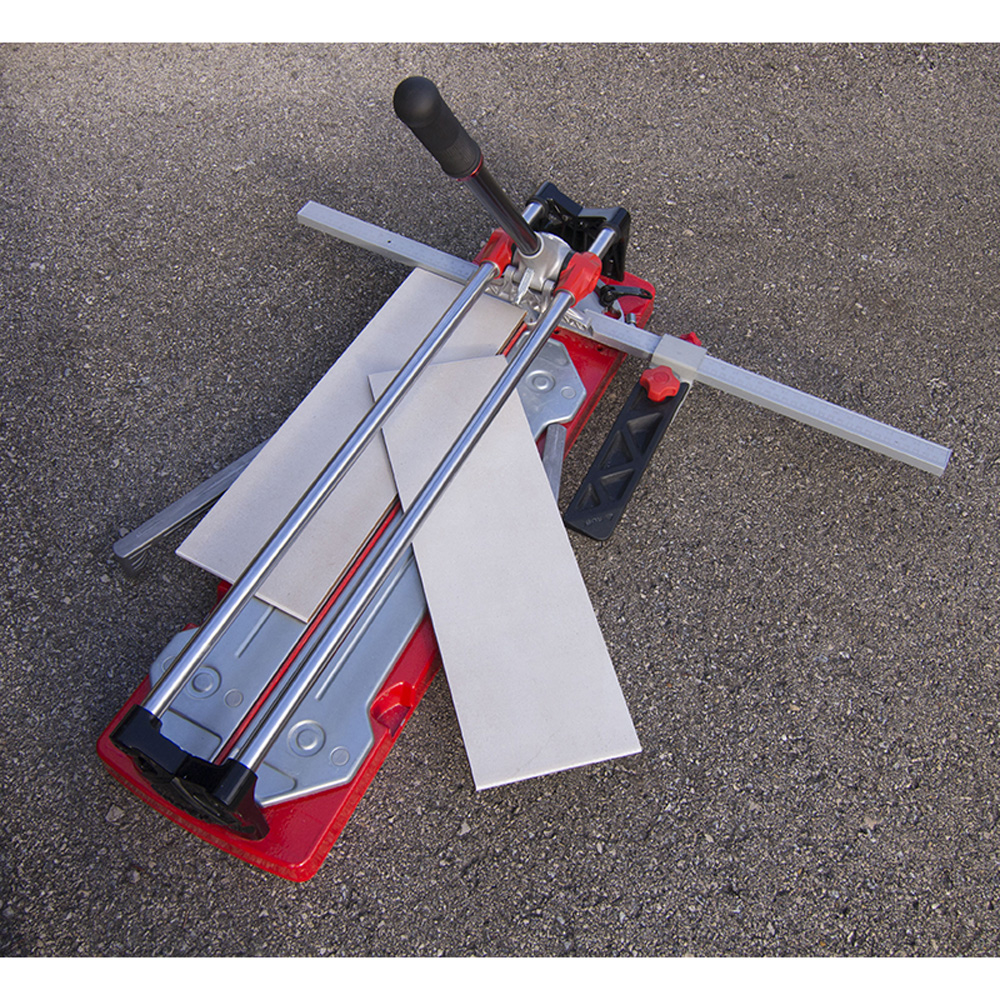Tile cutting is one of the most important steps in any tiling project. Whether you’re working on a bathroom, kitchen, or a large commercial space, choosing the right tile cutter can make or break your job. But with so many options on the market, it can be tricky to figure out which tool is best suited for your specific needs.
In this guide, we’ll walk you through the different types of tile cutters available—from manual cutters to wet saws and angle grinders—and explain the benefits and uses of each one, with links to the brands we stock at The Tilers Hub.
1. Manual Tile Cutters
Manual tile cutters are the go-to tool for straightforward tile cutting tasks. These cutters use a scoring wheel to make precise incisions along the tile surface, which are then snapped off cleanly. They are perfect for straight cuts and are most commonly used for ceramic and porcelain tiles.
Benefits:
- Cost-effective: Manual tile cutters are generally more affordable than power tools.
- Portable: Lightweight and easy to transport, perfect for smaller jobs.
- Dust-free: No need for electricity or water, making them a cleaner option.
Uses:
- Ideal for small to medium-sized tiling projects.
- Great for making straight cuts on wall and floor tiles.
- Best used on ceramic and porcelain tiles.
Explore our range of manual tile cutters available at The Tilers Hub.
2. Wet Saws
Wet saws use a diamond-coated blade to cut through tiles with precision. Water is used to cool the blade and reduce dust, making them ideal for large or complex projects. Wet saws are particularly suited for harder tiles like natural stone, granite, and thick porcelain.
Benefits:
- Precision cutting: Wet saws can make clean, accurate cuts with minimal chipping.
- Great for complex cuts: These saws can handle curved, straight, and diagonal cuts.
- Suitable for harder materials: Capable of cutting through stone, marble, and granite.
Uses:
- Best for larger projects that require precision, such as commercial spaces or high-end renovations.
- Works well on hard materials like natural stone, granite, and thick porcelain.
- Perfect for intricate cuts that require a professional finish.
Check out our selection of wet saws to find the right one for your project.
3. Angle Grinders
Angle grinders are handheld tools with a spinning disc that can cut through tiles, metal, and other materials. They are extremely versatile and can be used for straight, curved, and irregular cuts, though they typically generate more dust than other cutting tools.
Benefits:
- Versatile: Can be used for a wide variety of materials beyond just tiles.
- Compact and powerful: Great for cutting into tight corners or making quick cuts.
- Portable: Easy to carry around and use for quick, on-the-spot adjustments.
Uses:
- Suitable for making irregular cuts or cutting out small sections of tiles.
- Ideal for jobs where you need to work around obstacles such as pipes or fittings.
- Perfect for exterior tiles and projects where the cuts don’t need to be perfectly smooth.
Browse our range of angle grinders to find a tool that fits your needs.
4. Circular Tile Hand Saws
Circular tile hand saws, like the Rubi TC-125 G2, are specifically designed for precision cutting of tiles, especially large-format tiles. These saws are fitted with a diamond blade and can cut through various types of tiles, including porcelain and stone. They’re lightweight, making them easy to manoeuvre for straight cuts and long tile edges, often used with guide rails for added accuracy.
Benefits:
- Precision cutting: Designed for cutting large-format tiles with precision.
- Portability: Lightweight and easy to handle, perfect for on-site cutting.
- Smooth cuts: When used with a guide rail, these saws deliver clean, straight cuts with minimal chipping.
Uses:
- Ideal for large-format porcelain, ceramic, or stone tiles.
- Best for cutting long, straight edges and mitre cuts.
- Suitable for professional tilers who need a portable yet precise cutting tool for large tiles.
Explore the Rubi TC-125 G2 Circular Tile Hand Saw for your next big project.
5. Tabletop Tile Saws
Tabletop tile saws, also known as tile saw tables, offer a high level of precision and control. These saws are fixed machines with a water-cooled diamond blade, similar to wet saws, but they provide greater stability for large and heavy tiles.
Benefits:
- High precision: The stability of the saw table allows for extremely precise cuts.
- Ease of use: The table supports the tile while cutting, reducing the risk of errors.
- Suitable for large tiles: Ideal for cutting larger tiles that require careful handling.
Uses:
- Perfect for cutting large-format tiles.
- Suitable for professional tilers who need a reliable, high-precision tool for heavy-duty cutting.
- Excellent for producing consistent, smooth cuts on projects that demand a flawless finish.
Check out the Rubi ND-200 Tabletop Wet Saw for precise, high-quality tile cutting.
Conclusion
Each type of tile cutter has its own unique benefits and is suited for different tasks, from basic straight cuts to complex, intricate shapes. Whether you’re a professional tiler or a DIY enthusiast, it’s important to choose the right tool for the job. Manual tile cutters are great for simple jobs, while wet saws and tabletop tile saws are perfect for larger or more complex projects. Angle grinders and circular tile hand saws offer versatility, making them ideal for irregular cuts and working with multiple materials.
At The Tilers Hub, we stock a wide range of tiling tools, including manual tile cutters, wet saws, angle grinders, and more. If you’re not sure which tool is right for your project, our expert team is always here to help. Explore our full range of tile cutters and other essential tiling tools today.
